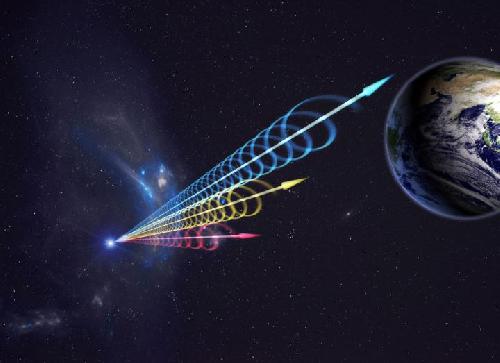PITTSBURGH--Fast Radio Bursts (FRBs), brief yet brilliant eruptions of cosmic radio waves from the distant universe, have baffled astronomers since they were first reported nearly a decade ago. Though they appear to come from the distant universe, none of these enigmatic events have revealed more than the slimmest details about how and where it formed, until now.
By poring over 650 hours of archival data from the National Science Foundation's (NSF) Green Bank Telescope (GBT), a team of astronomers, including Carnegie Mellon University's Jeffrey Peterson and Hsiu-Hsien Lin, has uncovered the most detailed record ever of an FRB. The group's research indicates that the burst originated inside a highly magnetized region of space, possibly linking it to a recent supernova or the interior of an active star-forming nebula. The results are published in the Dec. 3 issue of Nature.
Lasting only a fraction of a second yet packing a phenomenal amount of energy, FRBs are brief flashes of unknown origin that appear to come from random directions. Though only 15 have been documented to date, astronomers believe that the observable universe is rocked by thousands of these events each day.
 This is an artist impression of a Fast Radio Burst (FRB) reaching Earth. The colors represent the burst arriving at different radio wavelengths, with long wavelengths (red) arriving several seconds after short wavelengths (blue). This delay is called dispersion and occurs when radio waves travel through cosmic plasma. Credit: Credit: Jingchuan Yu, Beijing Planetarium
This is an artist impression of a Fast Radio Burst (FRB) reaching Earth. The colors represent the burst arriving at different radio wavelengths, with long wavelengths (red) arriving several seconds after short wavelengths (blue). This delay is called dispersion and occurs when radio waves travel through cosmic plasma. Credit: Credit: Jingchuan Yu, Beijing Planetarium
The team -- primarily researchers with cosmology backgrounds -- used new, highly specialized data-mining software to conduct an initial pass through the nearly 40 terabytes of GBT data to flag any candidate signals. The data-mining software, developed by Kiyoshi Masui of the University of British Columbia and Canadian Institute for Advanced Research and Jonathan Sievers of the University of KwaZulu-Natal in Durban, South Africa, yielded more than 6,000 possible FRBs. Lin, a doctoral student in Carnegie Mellon's Department of Physics, painstakingly analyzed the data from each of the signals, winnowing the field until only one candidate remained.
The newly discovered FRB, named FRB 110523, is in the frequency range of 700-900 MHz. Previously identified FRBs were all in the frequency range of 1.2-1.5 GHz.
"Until now, only 15 FRBs have been recorded. I feel extremely lucky to have identified the 16th," Lin said.. "Not only is this the first FRB in this frequency range, our FRB has provided us with a great deal of information that help us to better understand this astrophysical phenomenon."
The signal Lin found was exceptional. It contained more details about its polarization than any previously identified FRB. Polarization is a property of electromagnetic radiation, including light and radio waves, and indicates the orientation of the wave. Polarizing sunglasses use this property to block out a portion of the sun's rays and 3-D movies use it to achieve the illusion of depth. The new GBT detection includes both circular and linear polarization data, which is a first. Prior to this detection, only circular polarization was associated with an FRB.
"Hidden within an incredibly massive dataset, we found a very peculiar signal, one that matched all the known characterizes of a Fast Radio Burst, but with a tantalizing extra polarization element that we simply have never seen before," said Peterson, a faculty member in Carnegie Mellon's McWilliams Center for Cosmology.
The researchers used this additional information to determine that the radio light from the FRB exhibited Faraday rotation, the corkscrew-like twisting the radio waves acquire by passing through a powerful magnetic field. This provides clues as to the origin and environment surrounding the bursts, which will help theorists as they attempt to explain the bursts.
Further analysis of the signal reveals that it also passed through two distinct regions of ionized gas, called screens, on its way to Earth. By using the interplay between the two screens, the astronomers were able to determine their relative locations. The strongest screen is very near the burst's source -- within a hundred thousand light-years -- placing it inside the source's galaxy. Only two things could leave such an imprint on the signal, the researchers note: a nebula surrounding the source or the environment near the center of a galaxy.
"Taken together, these remarkable data reveal more about an FRB than we have ever seen before and give us important constraints on these mysterious events," concluded Masui. "We also have an exciting new tool to search through otherwise overwhelming archival data to uncover more examples and get closer to truly understanding their nature."
source: Carnegie Mellon University